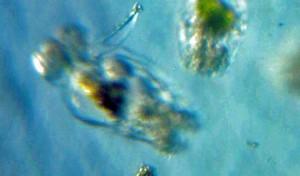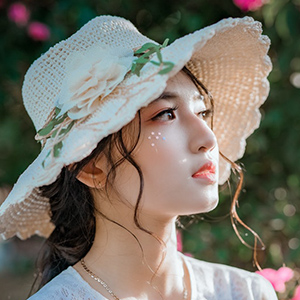Dyrkning rotiferer er ret let at gøre derhjemme. Rødfisk er en god fødekilde for nyklækkede fiskelarver og for nogle hvirvelløse dyr, der lever af filtre. Ironisk nok er den rotifer organismen i sig selv giver meget lidt næringsværdi til de dyr, der spiser dem.
 Det er indholdet i deres tarme (den mad, de spiser), der giver næring. Det er derfor vigtigt at fodre din rotiferer med en meget næringsrig fødekilde som fytoplankton. Hvis du er seriøs med at dyrke rotivere derhjemme, bør du også overveje at dyrke fytoplankton. Det er vigtigt at holde kulturerne adskilt og undgå kontaminering, men de færdigheder, der er nødvendige for at dyrke fytoplankton og rotivere, er ens. Du kan få flere oplysninger om fytoplanktonkultur på siden om fytoplankton.
Det er indholdet i deres tarme (den mad, de spiser), der giver næring. Det er derfor vigtigt at fodre din rotiferer med en meget næringsrig fødekilde som fytoplankton. Hvis du er seriøs med at dyrke rotivere derhjemme, bør du også overveje at dyrke fytoplankton. Det er vigtigt at holde kulturerne adskilt og undgå kontaminering, men de færdigheder, der er nødvendige for at dyrke fytoplankton og rotivere, er ens. Du kan få flere oplysninger om fytoplanktonkultur på siden om fytoplankton.
Der er to populære måder at dyrke rotivere på: som en kontinuerlig kultur eller som en batchkultur. I det følgende blogindlæg præsenteres den protokol, jeg følger for at dyrke rotivere i batchkultur derhjemme.
Opsætning og protokol for rotiferbatchkultur
- Cut 3 lengths of 12-inch rigid tubing and 4 lengths of flexible tubing: 3 long enough to reach from the bottles to the splitter and the fourth long enough to run from the air pump to the splitter Attach flexible tubing to splitter, pump and rigid tubing. Insert rigid tubing into culture bottle Turn on the air pump Fill bottles with a small amount of freshwater to test and make sure all 3 airlines create a modest flow of bubbles. Adjust the flow rate on the splitter as necessary to create a uniform moderate flow. Empty the bottles and inoculate the first bottle with a starter rotifer culture Add a few ounces of phytoplankton, make sure aeration is on, and watch the culture over each of the next few days. When the water ‘clears’ to a light green tea-colored tint, and you can see little specs in the water when you hold the bottle up to a bright light, add a few ounces more phytoplankton. Over a few days, by adding more phytoplankton when the culture clears, increase the total culture volume to about 3⁄4 of the bottle (about 1.5L After another 1-2 more days, once the1.5 liters of rotifers have cleared the phytoplankton, it’s time to start your second culture. Take approximately 1/3 of the culture (approximately 0.5L) of the tea-colored liquid and pour it into a second plastic bottle. Fill each of the bottles to the top with phytoplankton. In this way, the original bottle will be ready to harvest about a day before the second bottle. Repeat this step to create as many culture bottles as you want. By varying the mixture of phytoplankton volume and rotifer culture volume (or density) you can optimize your cultures to be ready for harvest when you will need it. To harvest the rotifers, pour out about 3⁄4 of the tea-colored culture through a rotifer sieve (approximately 50-55 micron) and into a discard/water change bucket After you have ‘filtered’ 3⁄4 of the culture through the rotifer sieve, turn the sieve upside down over second bucket (or small office-sized trash can dedicated to fish-room use), scoop up a cupful of the discarded culture water and pour it slowly over the upside-down rotifer sieve, effectively reversing the flow of water and rinsing the collected rotifers into your collection bucket/trash can. Collect the concentrated rotifers, feed them to your tank or store them in the refrigerator for later Fill the rest of the bottle (the remaining 1.5 liters), with fresh phytoplankton and start bubbling again Saltvandsakvarium Blog Tip : I stedet for at skylle rotiferne fra rotifersiven med kasseret kulturvand kan du erstatte det med vand fra dit udstillingsakvarium eller med frisk saltvand. På den måde kan du tilsætte rotifer til dit udstillingsakvarium uden at tilsætte urenheder fra kulturvandet. Tip til avancerede akvarister : Nøglen til at overleve kulturnedbrud - som du vil opleve - er redundans. Du bør altid have flere kulturer i gang på samme tid. Hvis du gør det, er der gode chancer for, at mindst et par rotivere fra en af kulturerne vil overleve. Læg den eller de nedbrudte kulturer til side, skaf nogle nye plastikflasker og brug de overlevende til at så en ny batch.
Dette er det tredje indlæg i en serie om dyrkning af rotifers i saltvand.
For at vende tilbage til det tidligere indlæg om det udstyr, der kræves for at dyrke rotifere, klik her
For at fortsætte til næste indlæg om kontinuerlige rotiferkulturer klik her

